by Lisa Blackmore, University of Essex, entre—ríos, and Emilio Chapela, Independent Scholar, entre—ríos
Reflecting on environmental humanities research, transdisciplinary methods and public engagement, this text accounts for the context and creation of entre-rios.net —a digital platform that collates arts research-led projects focused on the wellbeing of rivers. Founded in 2019, entre—ríos (meaning “between rivers”) began as a site-specific research project, which hosted a three-week program of an exhibition, workshops, and fieldwork excursions in Colombia, and produced a digital publication (see Blackmore & Domínguez, 2021). During the Covid pandemic, like many other projects, entre—ríos was forced to migrate away from the field and to virtual realms. Its core mission has endured in the quest to ignite connections between bodies of water, artists, communities, and institutions to recognise rivers as active subjects that produce aesthetic forms, transform landscapes, and shape memory. The project's platform, entre-rios.net, features commissioned projects by artists, curated exhibitions (digital and face-to-face), a media archive, performance-oriented workshops, and texts and visual essays made by students and emerging researchers in Latin America. The discussion to follow situates entre-rios.net in the context of emergent digital humanities practice, offers a brief overview of its digital curatorial and engagement work, and focusses, more specifically, on how the platform addresses the challenge of generating intimacy between users and research, drawing on feminist discussions of affect and examples of specific art research projects.
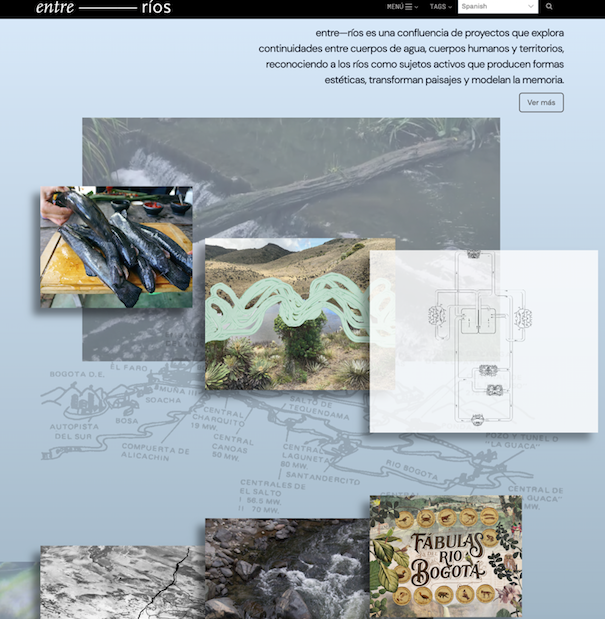
Image: Landing page entre-rios.net
Digital Environmental Humanities
Urgent ecological challenges require novel methodologies and practices to generate knowledge communities of solidarity and care that cultivate “response-ability” (Haraway 2016) toward environmental problems. Digital Environmental Humanities (DEH) scholars propose that interactive interfaces are powerful means to dissolve disciplinary and institutional silos and to close geographical and digital divides (Dixon, Bergmann, Legg & Crampsie 2022). Scholarship on DEH highlights the affordances of diverse methods and tools, including web-based collections, mapping, coding, and immersive environments for both research and teaching (Dixon, Bergmann, Legg & Crampsie 2022; Travis et al 2022). Approaches range from IT-focused engagements with "Humanities Big Data" (Travis and Holm 2016) to creative "digital geopoetics" (Dixon, Bergmann, Legg & Crampsie 2022) that nuance the data-heavy setting of the Anthropocene through aesthetic mediations that account for planetary being in ecological crisis via a rich audiovisual sensorium, and arts-led research (e.g. Environment and Society Portal; Anthropocene Curriculum). Similarly concerned with reaching more diverse audiences, in the Environmental Humanities practice research enables engaged scholarship and public engagement to extend beyond academic milieux into active communities (Jorgensen 2022; Blackmore 2022a; Blackmore 2022b). At the intersection of digital and environmental humanities, the past decade has seen a rise in online exhibitions and dissemination platforms that serve these ends. In this field, multilingual digital platforms promote the democratisation of knowledge in many ways: they collate and disseminate popular oral testimonies (e.g. Quipu Project); they assemble new critical and creative vocabularies to think the Anthropocene in transnational contexts (e.g. Feral Atlas); and they enact countermapping of people and sites subjected to cognitive justice and violent usurpation (e.g. Memória da Terra 2022). Through these practices and examples, it is possible to envisage emergent arenas that bridge scholarship, research, and activism.
Cultivating Intimacy
After not being able to attend to the UN conference for women in 1995 in China, and more than twenty years before the COVID pandemic, Sarah Ahmed posed questions aimed at re-thinking the role of intimacy in the context of institutional feminist debate (Ahmed 1997). Ahmed explains that ‘touching’ — a form of being affected or moved that entails intimacy— does not seek to completely overcome the boundaries that constitute the self and other, but instead entails animating (moving) those boundaries: letting oneself become affected by others, exchanging, relating and becoming vulnerable. Touching is a matter of response to others, human and non-human through dynamics of intra-action (Barad 2014). BBeing intimate entails responsibility and ethics. By the same token, being intimate with bodies of water means animating our borders, shifting places, responding, and recognising our entanglement and permeability. In short, it means caring.
By the same logic as physical proximity does not guarantee meaningful and affective engagements, the use of digital interfaces that bring people together does not suffice to build intimate and meaningful relations of care towards the environment. Instead, togetherness amongst humans and nonhumans is a matter of enabling spaces for discussion and affective engagement. By mentioning the environment, it is brought to the foreground (Morton 2007). Or rather, it ceases being something that it is out-there or around us, no longer background nor foreground. That movement is what entre-rios.net set out to nurture.
Digital Channels
Inquiries around intimacy, touch and connection have become increasingly important in the context of today’s digital interconnected world: Is distance reducible to physical distance? Does the sole fact of getting together guarantee the over-coming of distance? Or alternatively, is it possible to nurture intimacy despite physical separation? For many of us, this last question was abruptly brought to the foreground as the result of the global pandemic. And it was in that context that entre-rios.net was created. To address these inquires, the curatorial team (the authors and Diego Chocano) conceived with the Colombian digital designer David Medina a space and community imagined as an active and permeable entity, where artists could develop river-related projects during lockdown. The methodology consisted of a series of workshops and online meetings during the Covid-19 lockdowns of 2020, in which where artists were able to share their work and listen to invited researchers from other disciplines (such as hydrobiology, geology and urban history), as well as receive feedback and guidance from the other members. The arts research commissioned responded to the highly polluted and anthropogenically altered Bogotá River in Colombia and the Rímac in Perú, and the healthy but under threat Usumacinta River in Mexico.
The projects produced by artists in the three countries and published at the end of 2020 explore various forms of digital and riverine narratives that nurture intimacy and care in collaboration with bodies of water through four curatorial channels, which are not exclusive categories: Bodies of Water; More-than-human Assemblages; Ways of Inhabiting; River Voices.
Bodies of Water inquires on the personal, physical, affective and communal heterogenous capacities and permeations of our bodies to express as individualized bodies while participating too in the realm of the planetary? What ethical responsibilities and actions of care does this transcorporeality entail? We are solid and liquid bodies at the same time; determined but without borders; healthy and sick. How do we negotiate this ambivalence? How do we imagine and activate fairer inter-permeations?
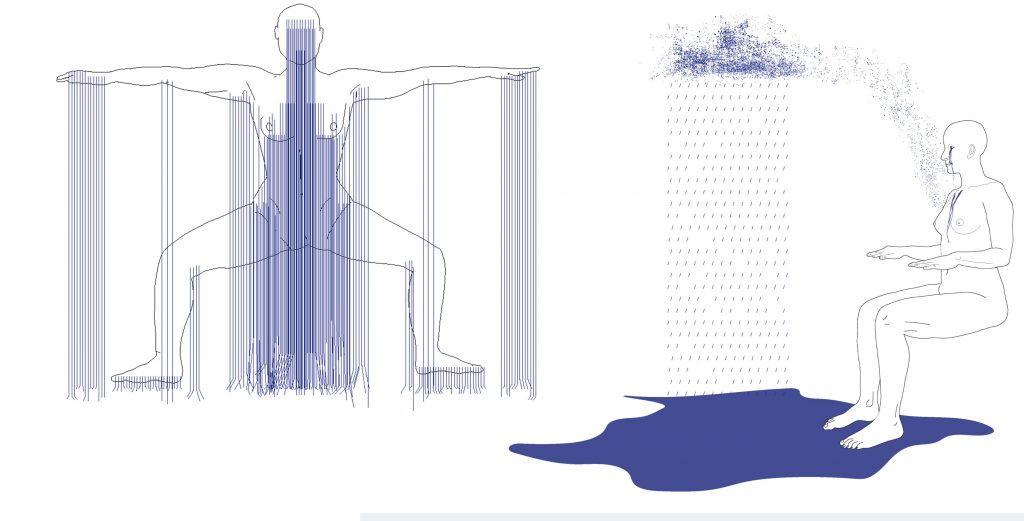
Image from Genietta Varsi, Sistemas de flujos desde el cuerpo humano. 2020. https://entre-rios.net/sistemas-de-flujos-desde-el-cuerpo-humano/
More-than-Human Assemblages proposes vital and material connections between humans and nonhumans by problematizing anthropocentric and extractive considerations. They inquire about infrastructure works and industrial activities that depend on rivers and their communities. They wonder how political economies and economic policies have affected rivers throughout history, by creating counterpoints between pre-modern traditions and practices and water cultures crossed by hydropower and industrialization.
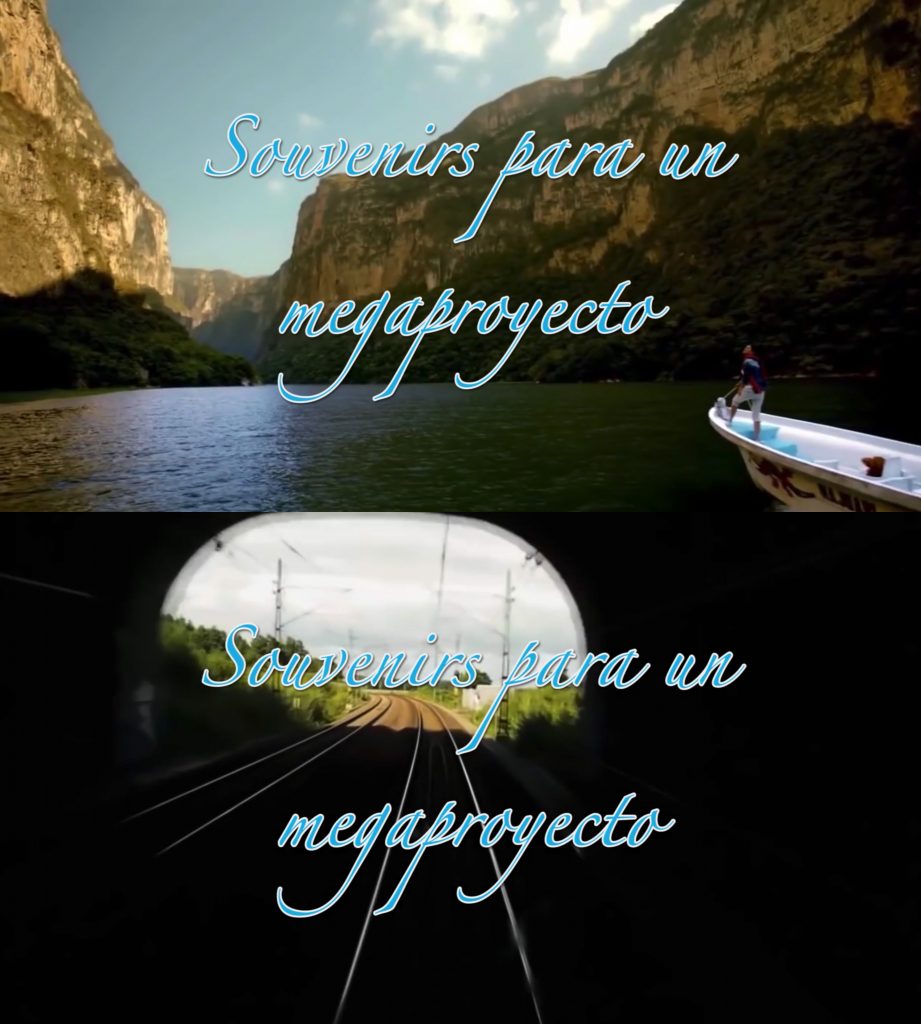
Image from Eduardo Abaroa, El tren desde el río. 2020. https://entre-rios.net/rio-tren
Ways of Inhabiting comprises projects that avoid social constructions and other forms of hegemonic representation of culture and science. They are interested in how life happens, in the movement and intensity of its encounters: in the subtleties, the imperfection, the contingent and its atmospheres. Avoiding nostalgia, they are concerned with the practices of the past: they seek to reconcile erased or violated practices to recover the material links between past, present and future.
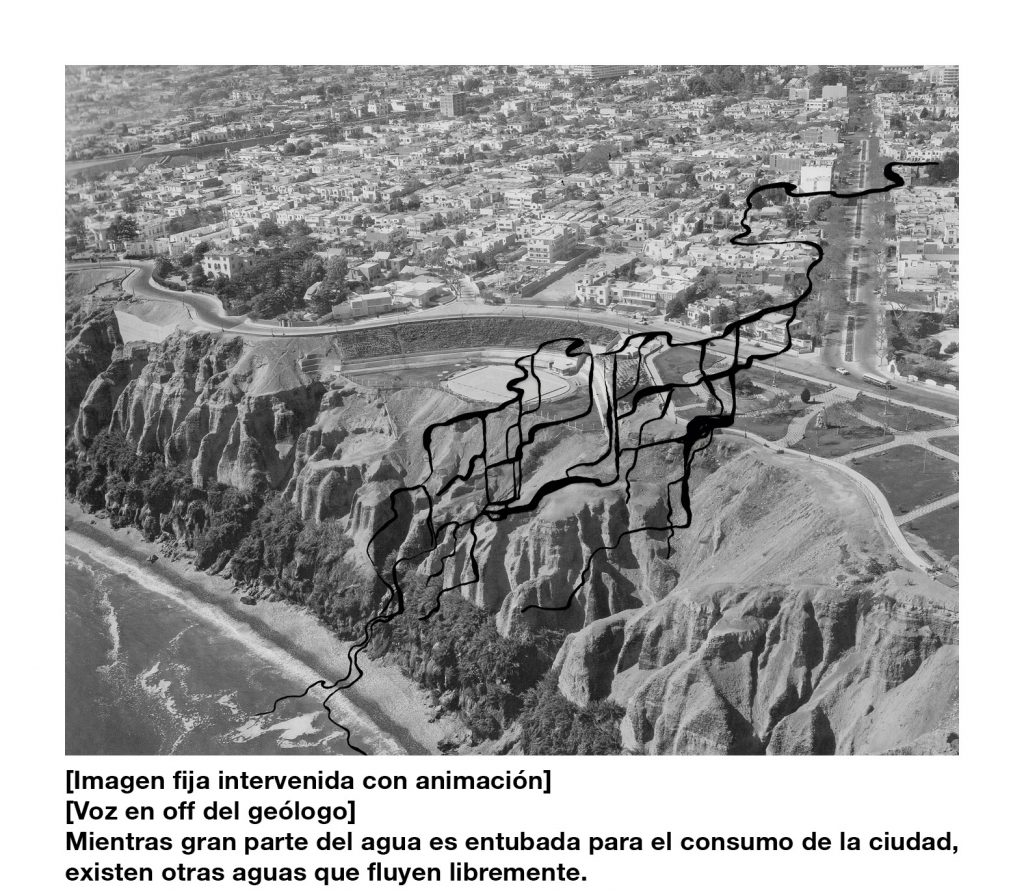
Image from Rafael Freyre y Ana Teresa Barboza, Canales subterráneos. 2020. https://entre-rios.net/canales-subterraneos/
The projects contained within River Voices invite us to relate with rivers by activating our anatomy on other bodies, from the tactile and the sound, creating shapes, encounters, vibrations, landscapes and memories, which help us explore the material, sculptural, sound and expressive potentialities of water, as well as our own capacities to listen attentively and respond in consequence.
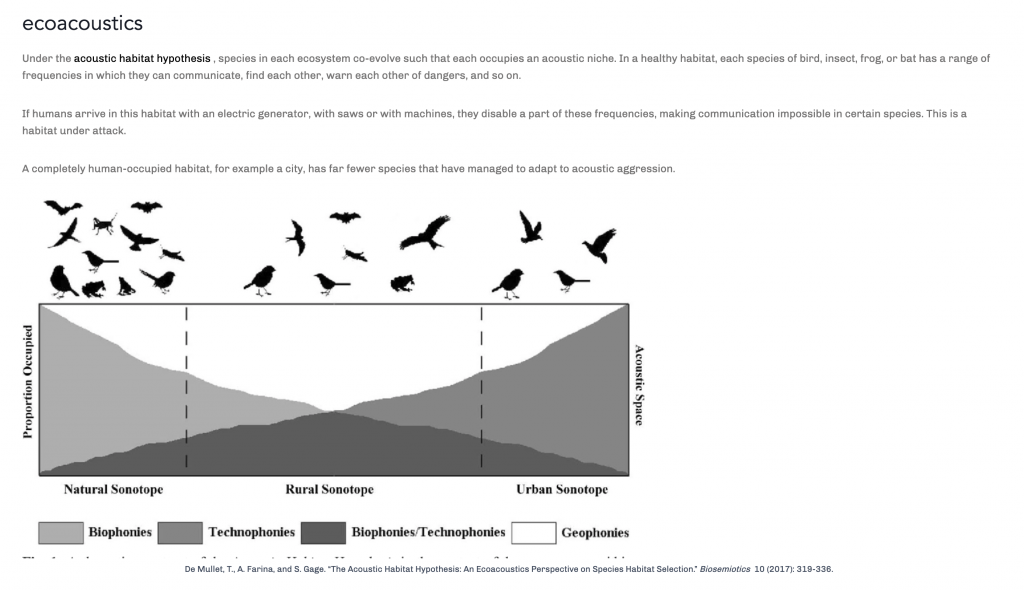
Elisa Schmelkes, Canto del río / ríos de canto. 2020. https://entre-rios.net/cantos-del-rio-rios-de-canto/
Between Rivers, In Between Spaces
Two further projects curated in 2021 — the hybrid digital and physical group exhibition Live Streams and the digital artwork, Es torrente y un hilo, by Colombian artist David Medina, commissioned by entre—ríos for Bienal del Sur in Argentina — also enabled our curatorial practice to stimulate the reconciliation and “making kin” between nature, culture, and technology to foster new (aesthetic) relations between humans and nonhumans (Huy 2017, Haraway 2016). Medina's Es torrente y un hilo (It is a torrent and a thread) is an interactive, live interface that unfolds as an endless flow of texts created by the artist and artificial intelligence. This hybrid entity, where the human and non-human merge and blur, troubles the authority of technological power while opening to the unpredictability of art practices: every time a user enters the interface, a text is produced by the AI, ramifying the consistent initial phrase ("It is a torrent and a thread...") into endlessly new directions through a never-ending flow of text that in its boundless motion also mirrors the dynamic and constant movement of rivers. Current debates about AI contest the need for limitations to such boundless non-human creation, however Medina’s hybrid entity is also anchored to its terrestrial existence: the interface changes colour across a mutating pattern that reflects the real-time engagement of the user with the actual time of Bogota, where the artist wrote the program. In this sense, the project —like entre—ríos — seeks to occupy an as-yet-undetermined space of agency between human-riverine subjects, and digital-offline practices.
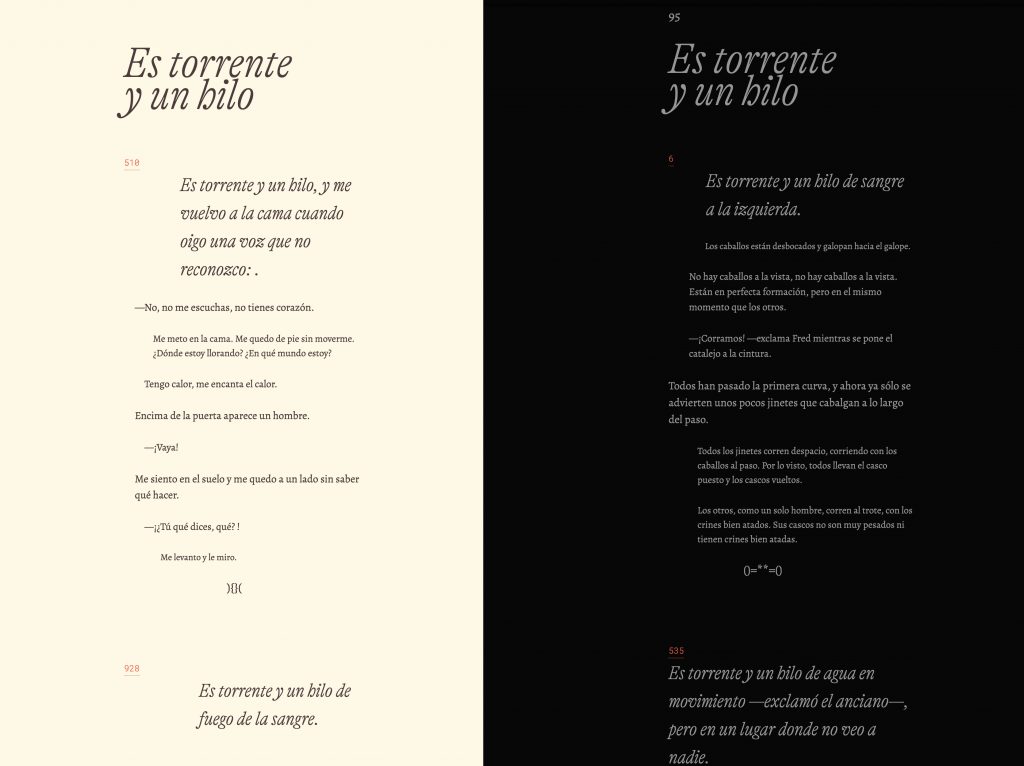
Screenshots from David Medina, Es torrente y un hilo, 2021-ongoing. https://estorrenteyunhilo.grama.co/
This same hybridity characterised the curatorial approach to the exhibition Live Streams, hosted simultaneously online at entre-rios.net and at the Art Exchange gallery at the University of Essex in 2021, just as Covid lockdowns were easing. In the gallery, the exhibition brought into dialogue works from the Essex Collection of Art from Latin America (ESCALA) with new works by artists active in entre—ríos, while the online space contained video works and provided a platform for the virtual public program. Digital connectivity in the program enabled a bridging of worlds between, for example, bilingual, artist-led participatory works, including a deep listening meditation with Colombian artist Leonel Vásquez and a somatic movement workshop with Peruvian artist Alejandra Ortiz de Zevallos, among other events, which provided a common experiential ground for participants (attending from Latin America, the United States and Europe) then to take part in exchanges that crossed disciplinary and geographical divides.
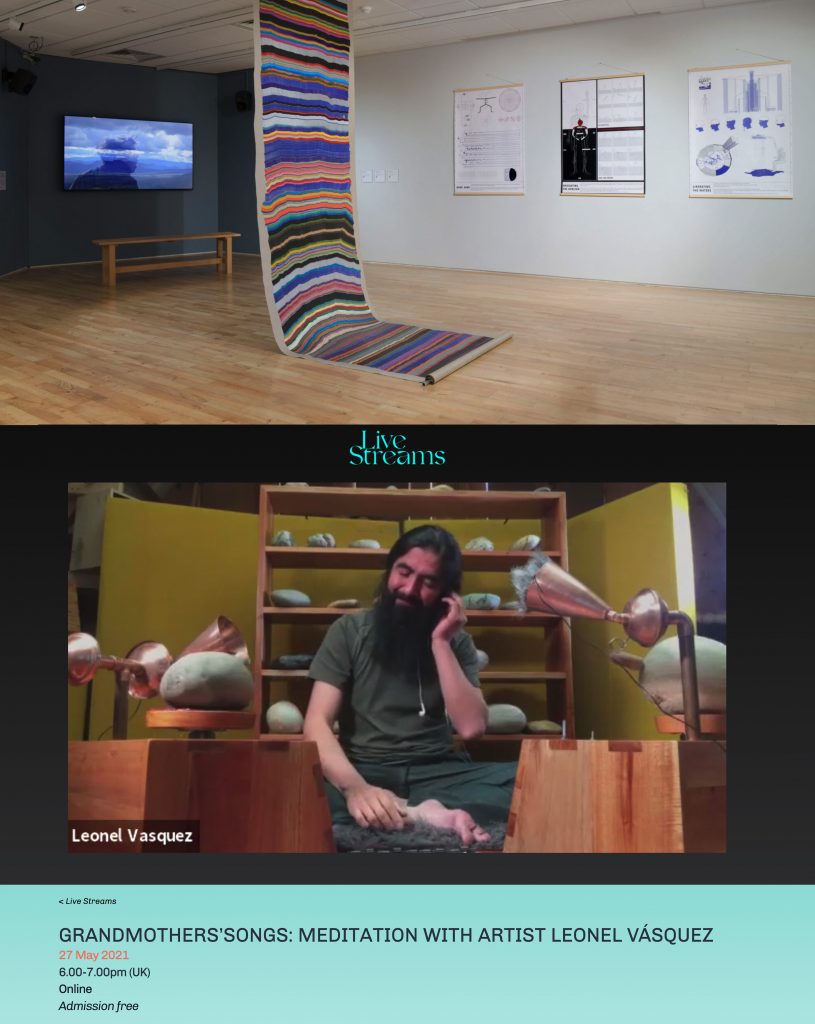
Above: Installation shot of Live Streams, Art Exchange, 2021. Below: Leonel Vásquez delivering a deep listening event for the Live Streams public program; https://entre-rios.net/livestreams/
Sustaining Engagement
Since 2021, entre-rios.net has grown, incorporating new edited arts research projects developed in rivers beyond the three original locations, including Colombia’s Atrato River (a subject of rights) and the countries receding tropical glaciers. The digital platform continues to offer a porous space for remote education (through courses delivered to universities in Latin America), and the production of Navigations (projects by students and emerging researchers related to entre-rios.net’s projects and bodies of water, more generally) that feed back into the platform in the form of video and text essays. This education and engagement phase is currently expanding to include a transnational, online seminar hosted via the platform in collaboration with various universities. Also, with the easing of Covid related restrictions, as an international research and engagement collective, entre—ríos continues to expand these digital channels while also returning to fieldwork projects, in person symposia and participatory events. While the global pandemic was a cruel teacher, the digital and hybrid environments it fostered have effectively created ways of connecting remotely to and through rivers —a mode of intimacy through transnational interrelation and interdisciplinary collaboration that our project is committed to sustaining.

Image: Menu of resources at entre-rios.net
About the Authors
entre—ríos is a confluence of projects that explores continuities between bodies of water, human bodies and territories. Working in person and online, we develop research, curatorial projects, seminars, publications, departing from artistic practices to generate collaborative experiments that connect us to the environment and to each other. entre—ríos was founded in 2018 by Lisa Blackmore and María Fernanda Domínguez. The current curators are Blackmore and Emilio Chapela. Connect with us at: http://entre-rios.net
Lisa Blackmore is a Senior Lecturer in Art History and Interdisciplinary Studies at the University of Essex. A specialist in Latin American Cultural Studies, Lisa works at the intersections of practice and research, combining writing on the arts and ecology with curatorial and audiovisual projects. She currently holds a British Academy Mid-Career Fellowship (2021-22): “Imagining the Hydrocommons: Water, Art and Infrastructure in Latin America.” She is the author of Spectacular Modernity: Dictatorship, Space and Visuality in Venezuela 1948-1958 (2017) and co-editor of Natura: Environmental Aesthetics After Landscape (2018) and Liquid Ecologies in Latin American and Caribbean Art (2020), among other publications.
Emilio Chapela is an artist and researcher, whose practice is informed by science and ecology. He aims to visualize bonds and connections between humans and nonhumans to reconcile with the world’s manifold temporalities and movements. He is a fellow at Sistema Nacional de Creadores de Arte (2022-2024) in Mexico. He has exhibited extensively in Mexico, Latinoamerica, the USA and Europe. His most recent Museum solo show was at Laboratorio Arte Alameda in Mexico City in 2019, where he collaborated with architects, astronomers and scientists. He has a PhD in artistic research from the University of Plymouth, UK.
Bibliography
Ahmed, Sara. “Intimate Touches: Proximity and Distance in International Feminist Dialogues.” Oxford Literary Review, vol. 19, no. 1, 1997, pp. 19–46.
Anthropocene Curriculum. http://www.anthropocene-curriculum.org/
Barad, Karen. “On Touching-the Inhuman That Therefore I Am.” Differences, vol. 23, no. 3, 2012, pp. 206–23, doi:10.1215/10407391-1892943.
Blackmore, Lisa. "Imaginando culturas hidrocomunes: prácticas curatoriales e investigaciones interdisciplinares entre ríos," Heterotopías 5, no. 10 (2022): 43-72.
Blackmore, Lisa & María Fernanda Domínguez (eds). entre—ríos: del páramo a la represa. Colchester: University of Essex, 2021.
Environment & Society Portal. https://www.environmentandsociety.org/
Feral Atlas. https://feralatlas.org/
Jørgensen, D. “Isn’t All Environmental Humanities ‘Environmental Humanities in Practice’?” Environmental Humanities 14, no. 1 (2022). DOI 10.1215/22011919-9481561.
Memoria da Terra. https://memoriadaterra.org/
Morton, Timothy. Ecology Without Nature. Cambridge: Harvard University Press, 2009.
Travis, Charles, Deborah P. Dixon, Luke Bergmann, Robert Legg, Arlene Crampsie. Routledge Handbook of the Digital Environmental Humanities. London: Routledge, 2022.
Travis Charles, Alexander von Lünen (eds). The Digital Arts and Humanities: Neogeography, Social Media and Big Data Integrations and Applications. New York: Springer, 2016.
Quipu Project. https://interactive.quipu-project.com/#/es/quipu/intro